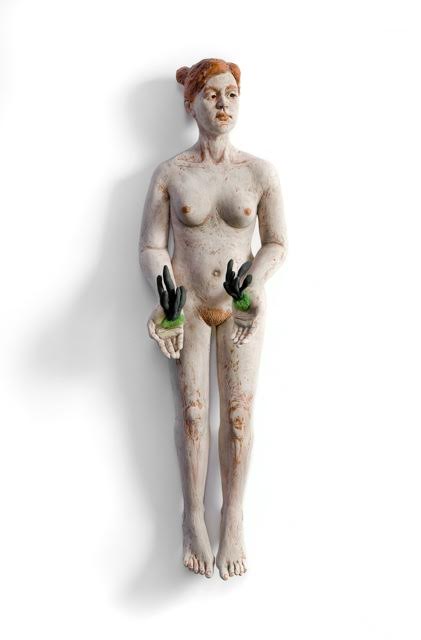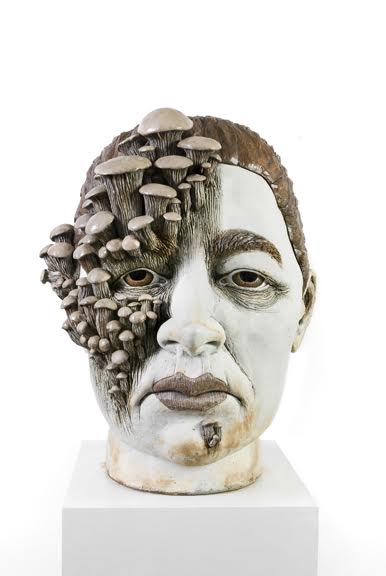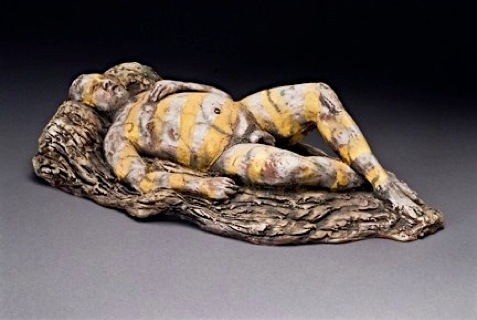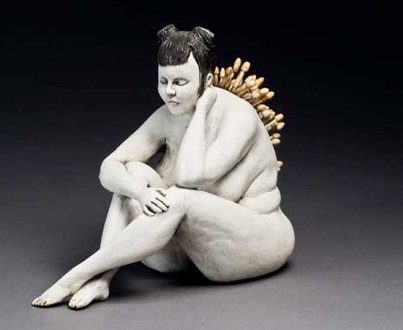Where does the drive to create art come from? Is it the desire of the artist to express an emotion, perhaps a means of reflecting nature’s beauty, or simply a hobby? On occasion, the move toward artistic expression spawns unintentionally from the need to have a voice, and what that voice has to say is often captivating. Figurative sculptor Laura Marmash sat down with Fine Art Today and discussed her unexpected journey to artistry, in which she fired her frustrations — both literally and symbolically.
Artists are a special breed because their spirit drives them to use various materials to express or reflect that which is meaningful to them. For artist Laura Marmash, personal expression through art came in 2008, when her role as an art director wasn’t fulfilling this need.
“My career started in advertising as a ‘creative,’ but I took a class at Lillstreet Art Center in Chicago just to be creative and make something that wasn’t to someone else’s specs or expectations — to have my own voice,” she says. “I think being a woman in a major advertising agency in Chicago — a man’s world — bred frustration. I often felt that I needed to have a dual personality: On the one hand, you needed to be the bitch who’s assertive to get things done, but other times I needed to placate and just go along to get along. I’m somewhere in the middle, but I found myself playing both roles and extremely frustrated.”
Marmash needed an outlet, and with her creative background, art was the natural course. In a fascinating and unexpected path, Marmash today is working in clay — producing figurative works that display complex and raw surfaces. Many of the subjects have unusual growths and patches of glaze that activate the visages.

Discussing her work, Marmash admits there’s a certain degree of morbidity and connotations of degradation, rebirth, aging, and nature. “I’m very inspired by thoughts of evolution, destruction, degradation, and how they relate to the body,” she says, “Five or six years ago, I visited a dermatologist, who began to investigate and remove pre-cancerous places from my fair skin. It really struck and inspired me, thinking about these oddities that surface as one ages.”
Indeed, Marmash’s creative use of glaze and color imbue her figures’ “skin” with individuality and irregularity. Some of them even display mushroom growths — another telling feature. The artist suggests, “I love the idea of how mushrooms take over an area and decompose/recycle the soil — how they filter and cleanse toxins from the earth in this cycle of degradation and rebirth in nature.” To work in clay was not a deliberate decision on the part of the artist, but it should come as no surprise, given Marmash’s sources of inspiration.

Working with the figure naturally has deeply personal connections, but it can also communicate broadly and universally. Marmash says, “I saw the work of Cristina Córdova, and it communicated to me on a fundamental level — it was an attraction that I could only express creatively through my own works.” In 2009, Marmash was lucky enough to attend a workshop with Córdova at Penland School of Crafts in Penland, North Carolina — an experience that launched Marmash into a more serious and dedicated process.
“It was such an incredible environment there,” she asserts. “I didn’t have to worry about cooking or cleaning; I could spend as much time in the studio as I wanted and completely immerse myself into learning from Córdova. There were also painters, weavers, wood carvers, sculptors, potters, and more, all together exchanging ideas and critiquing in the studio and at dinner — it was two weeks that gave me years of education.”

Marmash’s story offers a unique glimpse into the career of an immensely talented artist whose exploration of the figure and clay has only begun. She still has much to explore and understand about her voice and how she seeks to express it, but her current results are undeniable and profoundly beautiful. As the artist continues to grow, she hopes to refine and streamline her process. “I work so terribly slow, I’m like a snail,” she says. “I want to work quicker and in larger scale.”
Be that as it may, there seems little doubt that Marmash is ascending in her artistic career, and producing larger works is only a matter of time. Whether large or small, busts or full figures, abstracted or naturalistic, one can rest assured that whatever comes from the studio of Laura Marmash in the years to come will be something to see, admire, and collect.
To learn more, visit Laura Marmash.
This article by Andrew Webster was originally featured in 2017 in Fine Art Today, a weekly e-newsletter from Fine Art Connoisseur magazine.
> Sign up to receive Fine Art Today, our free weekly e-newsletter
> Click here to subscribe to Fine Art Connoisseur magazine, so you never miss an issue
Register for Realism Live here > realismlive.com








